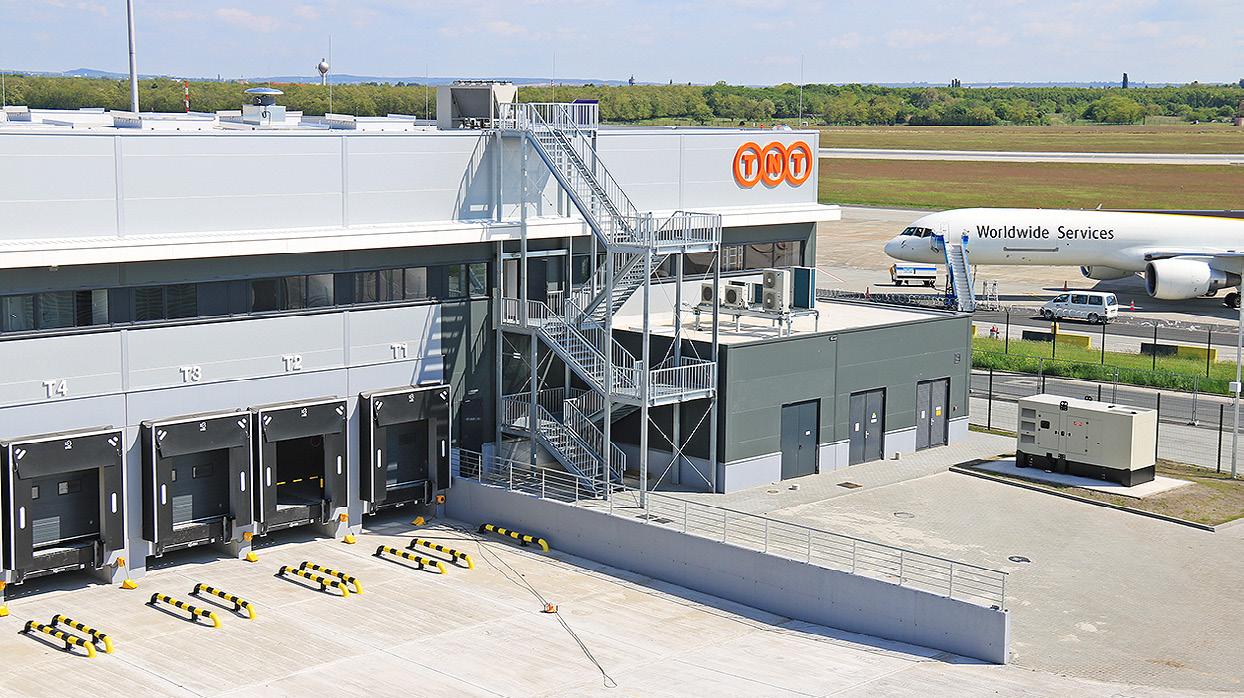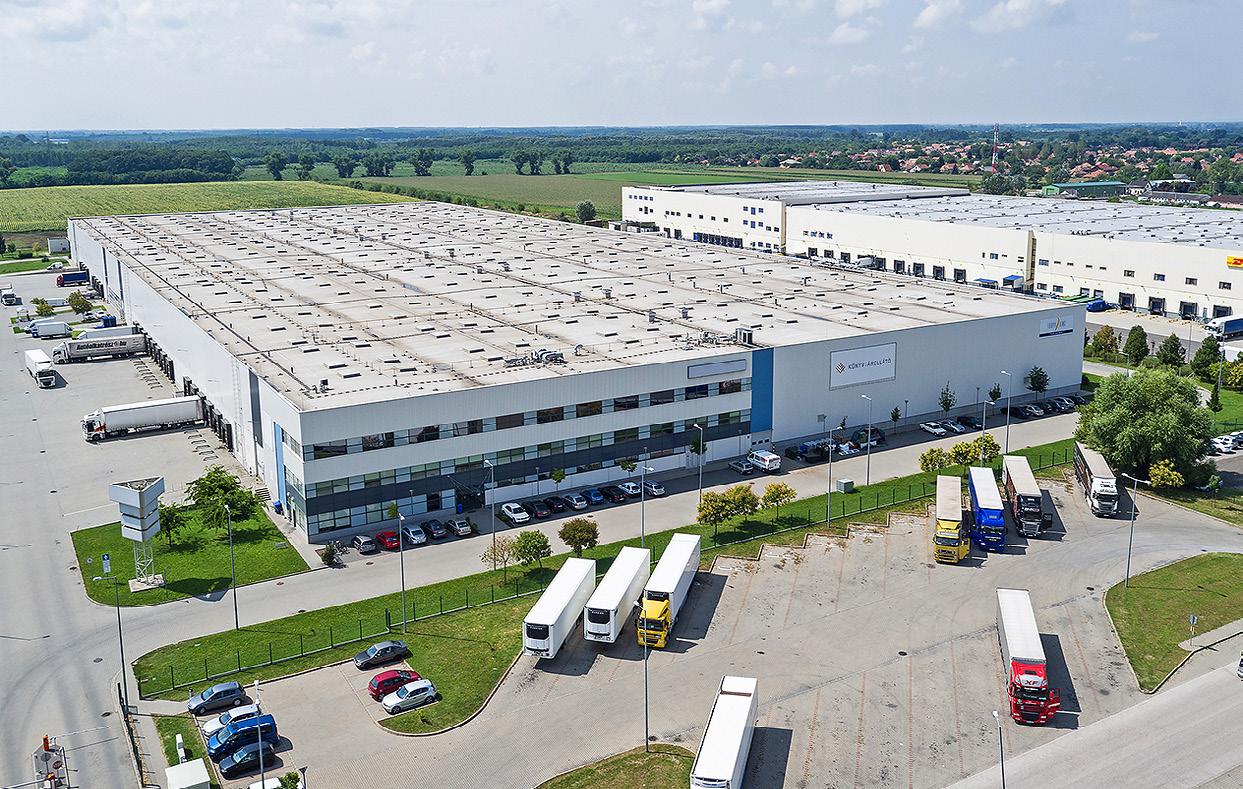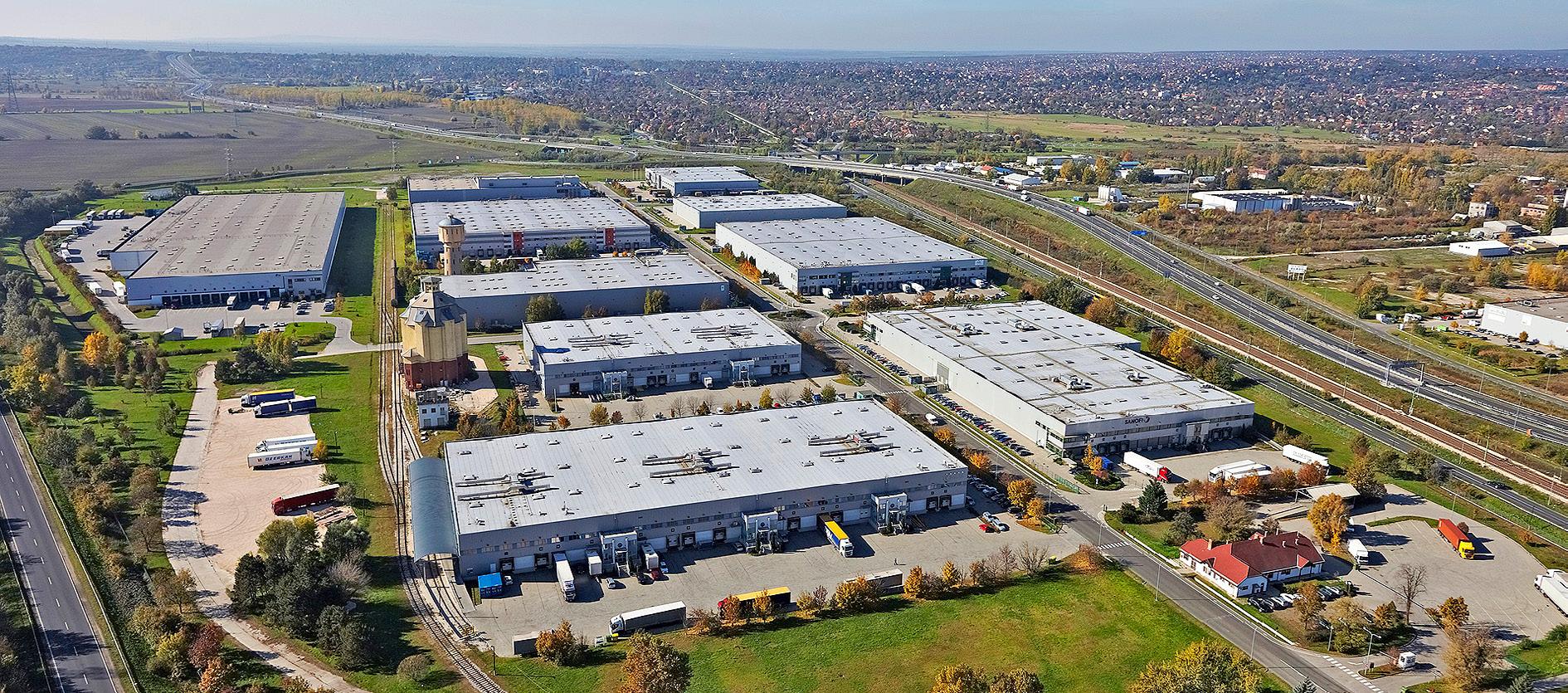
11 minute read
by low Availability
INDUSTRIAL MARKET GROWTH LIMITED BY LOW AVAILABILITY The limited availability of contiguous industrial space in the Budapest area and rising demand has resulted in a record low vacancy rate of 2.4% in a market with an estimated total stock of 2.18 million sqm, according to Cushman & Wakefield.
By Gary J. Morrell
Despite rising demand, further development of the Budapest industrial market is continuing to be impeded by a limited supply of space and take-up is dominated by renewals.
A further obstacle to market growth is that developer-led logistics projects are mainly limited to the greater Budapest area. However, there are signs of demand in regional cities, stimulated in particular by the automotive industry. Against this background, developers are now considering the speculative development option.
Goodman Üllő Airport Logistics Center.
more than nine million sqm as of the end of 2018. Of that, 3.16 million was developer-led and generally operates on a lease basis, while the rest was owneroccupied stock. The majority of the developer-led stock (some 2.18 million sqm) is located in the Budapest area.
“Last year brought the highest completion volume in a decade with 127,000 sqm of new space handed over. However, in terms of absolute volume as well as the nature of the delivered supply, this must still be considered rather conservative in the current market environment,” comments Gergely Baka, head of industrial and logistics at CBRE.
high demand, reflecting the indicators in wider European industrial markets. Total Central European industrial stock has surpassed the 27 million sqm threshold and most of the region has low vacancy at 5% or less.
Poland and Czech Republic continue to be the dominant markets, with 2018 supply at around 2.2 million sqm and 735,000 sqm respectively, compared to 127,000 sqm for Hungary, according to Cushman & Wakefield.
Andrea Pusztai, associate director of industrial agency at Colliers International Hungary, estimates the 2019 industrial pipeline for Hungary at 180,000 sqm. A significant proportion of this is pre-let.
FUNDAMENTAL CHANGE “In terms of new supply, we anticipate 100,000-150,000 sqm to be delivered to the greater Budapest market. The region continues to benefit from the fundamental change of risk perception following the 2008 economic downturn,” says László Kemenes, country manager at Prologis Hungary.
“A more disciplined approach to speculative development has contributed to a better-paced increase in new supply that is more easily absorbed by demand. There is a good chance that more than 50% of the new supply will be started on a speculative basis; however, that could alter throughout the year with any change in demand patterns. Speculative developments represent confidence in a given market and strong fundamentals stimulate this form of new supply. The increasing number of these developments has been driven by the low vacancy and strong demand throughout the CEE region,” Kemenes adds.
With these low vacancy rates, very limited availability and the high proportion of preleased pipeline, some leading developers are moving towards the speculative development option in established logistics parks, often as an addition to a built-to-suit (BTS) project. At the same time, BTS activity is expected to accelerate from tenants looking to secure space for both market entry and expansion.
“Looking ahead, the pipeline for 2019 looks similarly conservative in terms of volume, albeit with signs of increased willingness to undertake speculative projects, which would mark a turning point in the development cycle,” adds Baka.
In a recent transaction, the international industrial park operator and developer, Goodman, has delivered a new logistics center for Auchan Retail Hungary at the Üllő Airport Logistics Center. The logistics park is owned
and operated by Goodman, which will manage the new facility.
The 87,000 sqm center is the largest of its kind yet built in Hungary according to the French supermarket chain, and will handle Auchan’s food and non-food logistics, while also supporting the company’s on-line commerce in Hungary.
According to István Kerekes, country manager of Goodman Hungary, the developer’s business model provides what it describes as integrated “own plus develop plus manage” customer service. Goodman’s current portfolio in Hungary comprises warehouse and office space in two locations in Gyál and Üllő, both on the outskirts of the capital.
URBAN LOGISTICS Prologis has commenced construction of a 10,600 sqm speculative facility at Prologis Harbor Park. The company has a Hungarian portfolio of 580,000 sqm with close to 100% occupancy. László Kemenes sees a possible development in the Budapest market in the growth of smaller scale urban or city logistics facilities, following the trend in some of the larger European cities.
Another regional industrial developer, CTP plans to go ahead with a 32,000 sqm speculative development at CTPark Budapest West, a significant proportion of which is already let. With regard to supply, the company has hit the five million sqm mark in Central Europe.
“We have been working on buying strategically located land in the five capitals of the countries in which we operate. I am excited about the latest acquisitions in Budapest and we are now able to offer warehouse

properties all around the city,” says Remon Vos, CTP’s CEO.
The developer is also constructing a 22,000 sqm facility at CTPark Budapest South and plans to start construction of a further 20,000 sqm of space at CTPark Budapest East where there is 80,000 sqm build-out potential. At CTPark Arrabona in Győr (120 km west of Budapest), major Audi supplier Dana Hungary has requested a 9,000 sqm extension to its existing facility.
Rudolf Nemes, country manager at CTP Hungary, estimates the current pipeline at 20% speculative standard big box, against 80% customized BTS.
“CTP has started to build warehouses around Budapest on a speculative basis, without lease agreements in place at the acquisition or construction start. Due to strong demand, all of these developments are completed with low or zero vacancy. I could not imagine a better market environment than the one today,” he says.
Ferdinand Hlobil, head of CE industrial at Cushman & Wakefield, argues that in the current landlord

favorable market the majority of development is undertaken on a BTS basis as developers are quickly able to conclude deals for available development space.
TRACK RECORD According to Ádám Székely, managing director of the Hungarian developer Infogroup, “Speculative development is when a developer intends to comply with all kinds of market requests. This could be a fully prepared site with a building permit, or ready warehouse: in Infogroup’s industrial parks we provide both solutions. Industrial developments are typically BTS products. Logistic warehouses are partly built on speculative basis. In Polgár, where we have positive track records and are experiencing significant demand, speculative developments are feasible options.”
The lack of available warehouse space and rising cost of construction has put upward pressure on rents, which has resulted in about 13% year-onyear growth, according to Cushman & Wakefield. The company estimates prime logistics rents of EUR 4.25 per sqm per month as of the turn of the year. CBRE put headline rents for
East Gate Business Park by Wing.
speculative new developments in greater Budapest at EUR 4.4-4.8 per sqm per month and for BTS schemes at EUR 4.5-5. Rents at the low supply of city logistics centers are EUR 4.75-5.5.
“The biggest difference nowadays is that companies are ready to make their leasing decisions quicker than before. Pricing is not the major question, but flexibility and the ability to make changes in the daily operation have become a key factor. Although rental prices are increasing, the costs and duration of construction is not as predictable as before, which is a significant risk for developers,” Székely comments.
Logistics developers are building increasingly-complex industrial projects in reaction to developing tenant requirements such as automized warehouses and a growing concern with the working environment in tight labor markets.
As with other commercial real estate sectors, the major industrial park developers and operators are increasingly seeking third party sustainability accreditation from the likes of BREEAM and LEED. This is partly driven by tenants who
are looking to save on utility costs and developers needing to comply with international environmental regulations.
Further, the rising construction and labor costs are putting upward pressure on rents, increasing the need for ever more efficient logistics facilities and property management systems.
“Unemployment remains at a historic low, pushing the economy to its limits and industrial operations are working at maximum capacity. This encourages innovation and automization of warehouse operations,” comments Cushman & Wakefield.
3D DESIGN Prologis has commenced construction of a 10,600 sqm speculative facility at Prologis Harbor Park. The complex will be submitted for BREEAM “Very Good” accreditation. Prologis describes the complex as the first BIM (Building Information Modeling) designed logistics center in CEE. The system is a 3D model-based process that enables architectural, engineering and construction professionals to more efficiently plan, design, construct and manage buildings and infrastructure.
According to Prologis, sustainable features of the development will include high graded insulated wall panels and roof systems that, together with high performance gas fired heaters, can cut heating costs by 30%. Further, energy-efficient LED lighting and large skylights reduce electricity costs by 40% compared to the latest lighting standard. Smart metering will also optimize water, gas and electricity consumption in the complex.
“The importance of labor in warehouses has risen in the last decade. Access to qualified labor in the 12 European countries where Prologis operates is a key requirement for real estate selection,” the company explains.
“More than 150,000 people work under Prologis roofs in Europe and their environment has never been more important. A warehouse is no longer just a place for only storing goods. Higher value-added and complex activities now take place in logistics facilities, which require a much more diverse workforce than historical norms. We believe that the logistics market is on the verge of transforming the labor market. Automization/ robotics impacts labor demand. This is expected to reduce some pressure for lower qualified employees, but the need for higher qualified employees will only increase. As seen in other sectors, automization/robotics does not necessarily lead to a reduced need for staff; it leads to a changing composition of the employee skillset,” says Prologis. Both Wing and CPI Property Group, developers and commercial center owners who operate across the different commercial real estate sectors, have ongoing projects. Wing is operating the 100,000 sqm East Gate Business Park located on the M0-M3 motorway in the vicinity of the Budapest Ferenc Liszt International Airport. The complex has the possibility for 150,000 sqm of warehouse space when fully developed. Wing also operates the South-Pest Business Park, which has the possibility for 52,000 sqm of space when fully developed.
CPI is set to deliver a 13,000 sqm BTS building at the Airport City Logistics Park in Vecsés, which has a 55,000 sqm built-out potential.

The Ferenc Liszt International operator, Budapest Airport, has commenced construction of the 20,000 sqm first phase of its Cargo City project. The operator helped establish the Budapest Airport Region Cluster (BARC) in conjunction with local authorities to promote development of the airport and the surrounding area.
ROAD, RAIL AND AIR The cluster sees the improvement of national and international road and rail transport and the creation of a network of modern logistics facilities as central to the development of the airport and the surrounding area.
In contrast to its Central European neighbors, a developer-led industrial market has not emerged outside the capital, with only a handful of such projects established outside the greater Budapest area. However, demand from automotive and related companies is beginning to change this. Kecskemét (93 km southeast of Budapest), for example, is looking to become a new hotspot as developers hope to exploit their landbanks on the back of the expected supplier influx around the second Mercedes plant in the city.
“We believe an industrial market will develop outside the capital, just
take a look at Győr, Székesfehérvár or Tatabánya, or the current market developments in Kecskemét, Miskolc or Debrecen,” says Székely. His Infogroup has undertaken development of the Kecskemét South Industrial Park adjacent to Mercedes. The complex will consist of 55,000 sqm of logistics-industrial space in three speculative phases. In addition, 30 hectares of industrial plots are available for sale or to be developed on the basis of a BTS cooperation.
Nemes, of CTP Hungary, also sees a huge industrial market beyond the capital in Győr, Tatabánya, Székesfehérvár, Kecskemét, with the market in Miskolc also growing and Debrecen on the horizon. These are mainly driven by the automotive industry and therefore most buildings are customized. “We have a number of requirements (mainly related to production/assembly) for the major countryside locations, mostly connected to the automotive industry, but not yet a speculative market for developer/investors. So it is difficult to serve immediate interests,” comments Pusztai, of Colliers International.
“Moving forward the market is expected to remain BTS-dominated. In response to the increased cost of new development, developers are showing an increased interest in land banking, even in subprime Budapest locations, and are in a wait-and-see position, assessing their speculative build options,” concludes Gábor Halász-Csatári of Cushman & Wakefield.












